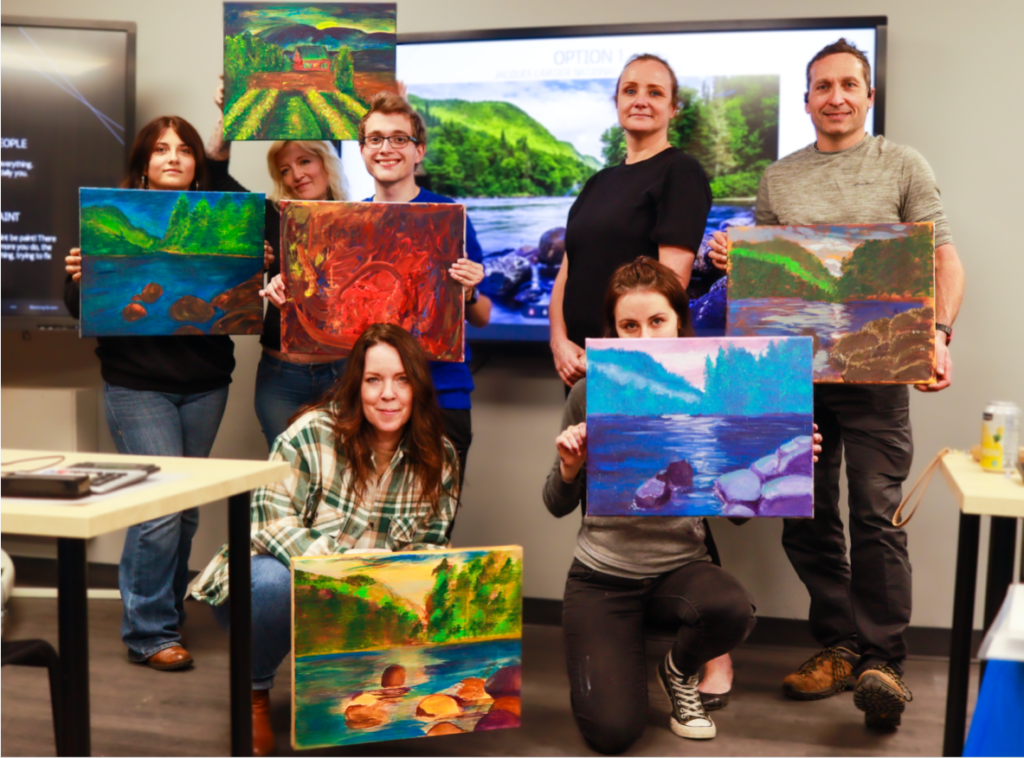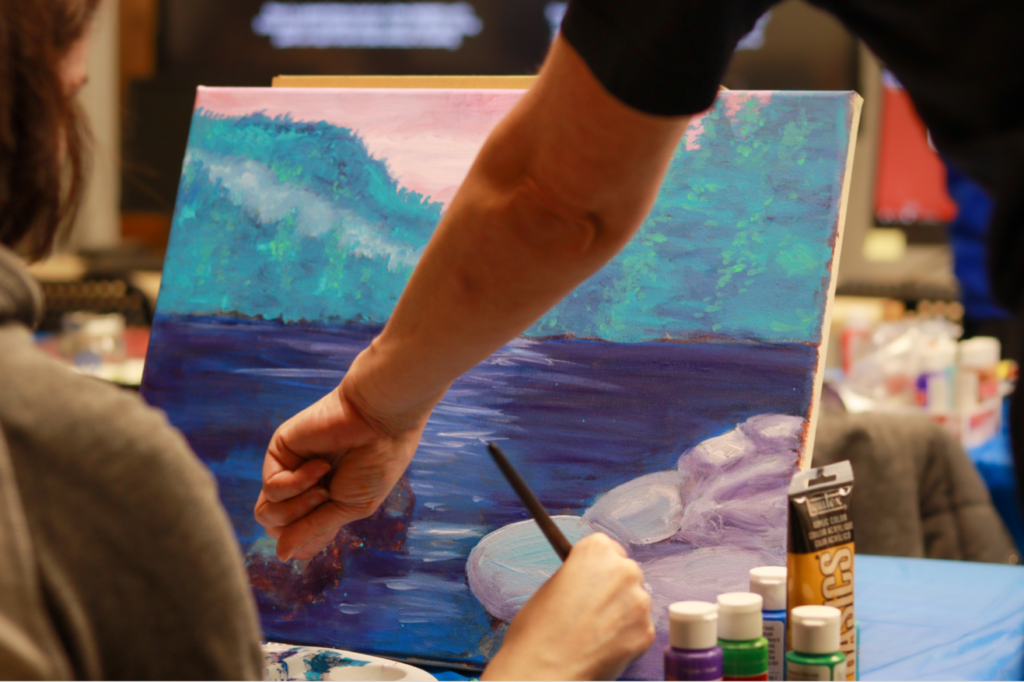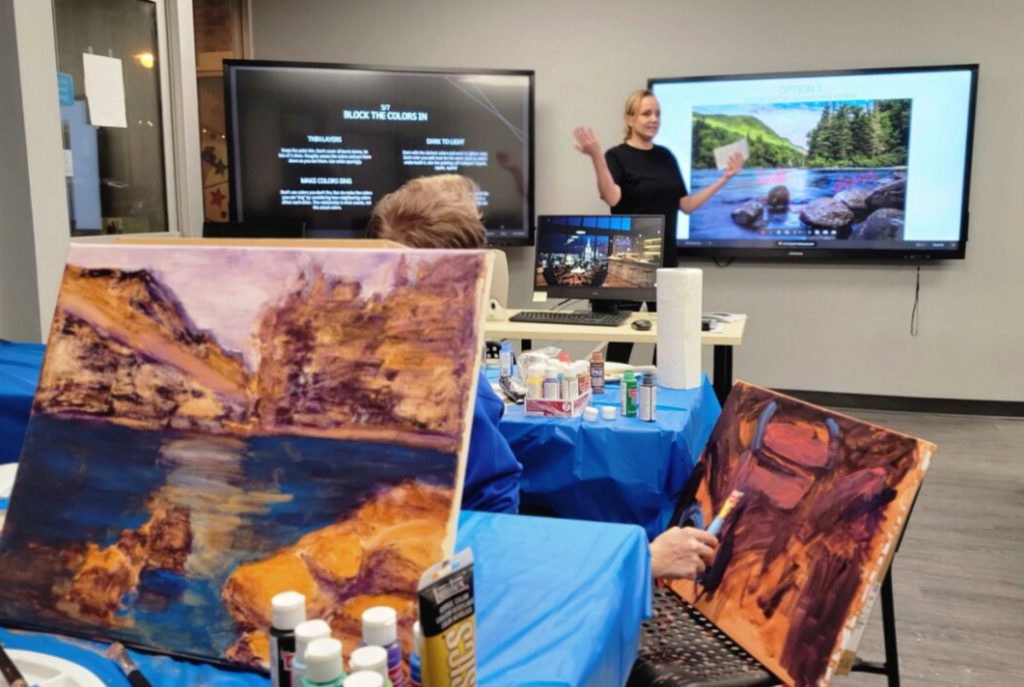
The Benefits of Painting
Registration is now open for September 2024 and Winter 2025. Consult our programs authorized by the Ministry of Higher Education. We also offer institutional certificate courses.

For centuries, the act of painting has been experienced as both a pleasurable pastime and an occupation. Even today, it remains a widely cherished hobby by people of all walks of life. “The global art market totaled $67.8 billion in 2022, growing by 3% year-over-year and reaching its second-highest level to date.” According to The Art Market 2023, authored by Dr. Clare McAndrew, Founder of Arts Economics and published by Art Basel in partnership with UBS.
However, painting is not confined to merely being a creative hobby. Did you know that when you are completely engaged in a creative activity, like painting, your mind can enter a ‘flow’ state, called ‘Alpha,’ where one side of the brain is conscious, while the other draws out the unconscious. Like meditation, during Alpha, your mind is capable of temporarily pushing aside distractions, worries and in certain instances even physical pain.
Painting can play a substantial role in strengthening the brain’s performance, promoting overall wellbeing, enhance learners’ academic development and even fosters the development of soft skills that have the capacity to grow your career.
“Talent is a pursued interest. Anything that you’re willing to practice, you can do.”
-Bob Ross (October 29, 1942 – July 4, 1995)
American painter, art instructor, and television host.
Additionally, its highly effective therapeutic and calming techniques, for instance, can significantly contribute to improving mental and physical well-being, which is critical for students, employees or anyone experiencing stress regarding their studies, work, or personal life.
From unlocking hidden powers of the mind to further your development, to tapping into mental and emotional well-being, or igniting your creative potential, following are at least five powerful benefits of painting.

Starting with the obvious, your creativity will expand as you consciously open your mind to various sources of inspiration.
1981 joint-Nobel Prize winner and psychobiologist Roger W. Sperry (August 20, 1913 – April 17, 1994) theorized that the right cerebral hemisphere can perform visuospatial tasks better than the left part of the brain. He believed that right-brain thinkers were more visual and creative, whereas left-brain thinkers were more logical and analytical.
However, when you paint, both hemispheres workout together; to research and process inspirational resources, brainstorm ideas, plan your art-piece, learn different techniques, assess applications, and experiment with materials and color combinations to create something new. Painting is a cerebral workout that leads to creative growth.
“Painting embraces all the ten functions of the eye; that is to say, darkness, light, body and colour, shape and location, distance and closeness, motion and rest.”
-Leonardo da Vinci (April 15, 1452 – May 2, 1519)
Famous Italian Artist and Polymath
As you paint, your mind is visualizing the end-result and remembering your initial ideas and inspirations you are now putting on canvas. You are continuously tapping into and developing your memory skills, as your mind sharpens through conceptual visualization and implementation.
Understanding medical reports that describe the importance and effect of creativity on Alzheimer’s patients, as seen for example in an article written by Dr Luis Fornazzari, MD which reports the case of a talented artist with the diagnosis of early onset Alzheimer disease (AD) with progressive cognitive impairment but with preservation of her creativity until very late in the course of the disease (first published in 2015, by Dr Luis Fornazzari, MD FRCP(C), Clinical Director (A) at Multilingual Multicultural Memory Clinic in Toronto, Ontario , in the Official Journal Of The European Academy of Neurology), it is to no surprise that painting boosts brain function, like jogging advances a runner’s performance.
While you are painting, you are also improving the development of your spatial awareness, since you mentally evaluate the placement, shape, size, texture, color of each element you add, in contrast or harmony with the previous and next elements.
From business managers to math tutors, from programmer analysts to college students, or anyone holding a paint brush dipped in paint; all need to think conceptually to identify solutions to the situation at hand. Thinking outside of the box quickly becomes second nature to an experienced painter, and that is one skill that brought opportunity and success to many scholars, careers, and industries.
Painting promotes critical thinking. Whether it is taking a step back to see the bigger picture and draw connections between different elements to create a whole. Or adjusting to limitations or unexpected outcomes during the creative process. Your creative vision develops as you paint and with each new project you practice valuable problem-solving skills.
“Creativity is allowing yourself to make mistakes. Art is knowing which ones to keep.”
-Scott Adams (born June 8, 1957)
American Author and Cartoonist
A new and alarming phenomenon is rising on the horizon, and that is a lack of dexterity in fingers and hands, attributed to the increase of touch screen technology and decreased use of pencils, scissors, and other manipulatives. Every time you handle a tool, like a paintbrush, a keyboard, or a screwdriver, you are forming muscular and neural connections that are crucial for activities like typing, handwriting, or for example the repair of small, computerized hardware components, and many more every-day- activities at work and around the house and workplace.

The demanding life of a college student leads to quite a bit of mental strain and negative emotions. Painting provides a relaxing, non-threatening environment where students can find a creative outlet to give shape to difficult emotions, removing the anxiety involved when keeping feelings locked up. The sense of accomplishment when expanding artistic skills, as well as the admiration a painter receives on their visually appealing artwork, gives a sense of pride and contentment.
While learning how to paint realistic pedals of a flower, or fur on a puppy, you will learn to embrace the beauty around you and gain a more positive outlook on the world. Reducing negativity in your life directly reduces the chance of mental illness or burnout.
Scripps Affiliated Medical Groups suggests that completing a painting, produces a surge of dopamine that makes people feel motivated and focused. Additionally, the reward of growing and expanding artistic skills creates a sense of accomplishment. Creating visually appealing artwork that others admire gives the painter a sense of pride and happiness in the work.
“The aim of art is to represent not the outward appearance of things, but their inward significance.”
-Aristotle (384 BC – 322 BC)
Greek Philosopher and Polymath
Socializing is a basic human need and nourishes both mental and physical health. Painting, learning, and experimenting together, inspiring each other, and discussing each others’ art will foster bonding and increase social skills, leading to overall joy and happiness. It also makes for a great icebreaker, a conversation topic, providing you with a shared interest with countless other art-appreciators and painters around the world.
Learning more about modern and historical art provides you with shareable knowledge, promoting sociability between various cultures. Painting Workshops can help as a great (corporate) team-building activity or simply a nice time to blow of steam.
While you paint, you tap into your subconscious and become inspired to communicate deep thoughts and feelings through the pieces you create. You may not be able to express those emotions and thoughts verbally. However, “a picture is worth a thousand words;” whether they reflect worldwide events or personal reflections. Being able to communicate non-verbally can promote emotional intelligence, better understanding of the people you serve and work with, it can provide you with an edge in marketing, as well as a healthy release of emotion.
The cognitive benefits of painting to overall health, well-being and performance are astoundingly valuable to both individuals as well as organizations. Painting builds strong mental health. It is clear why art therapy has now extended its reach beyond mental health institutions; to various community settings, including schools, colleges, universities, corporate organizations, nursing homes, residential treatment facilities, shelters, and halfway houses.
If you are ready to experience these health benefits of painting for yourself, and your classmates, coworkers, family, or friends too, sign up to Cestar College Campus Sherbrooke next painting workshop. Visit our website for dates and availability.
“Creative work is a gift to the world and every being in it. Don’t cheat us of your contribution. Give us what you’ve got.”
-Steven Pressfield (born September 1, 1943)
American Author of The War of Art

Debby Peetam hosts our painting workshop “7-Steps to a Successful Painting” which guides participants of all skill levels through the basics of creating a painting. Debby is a talented artist who works in a number of different mediums and has used her art skills to create meaningful personal art, work with high profile clients, and most importantly to her, enabled her to work with, and hopefully inspire a community of burgeoning artists. Formally trained at The Bertrand Russell College in Noord-Holland, the Netherlands (just outside of Amsterdam), Debby now leads the “7-Steps to a Successful Painting” program created by Canadian artist Brian Simons, where she can share her passion for acrylic painting with others.
7-Steps to a Successful Painting is a popular workshop that is offered on a fairly regular basis. Keep your eyes on our newsletters and social media so that you don’t miss the next session!